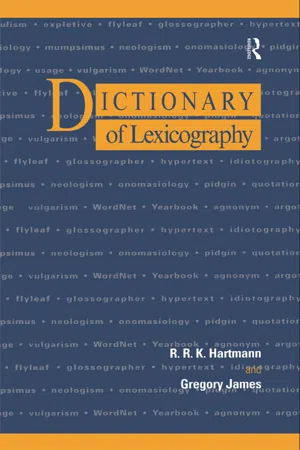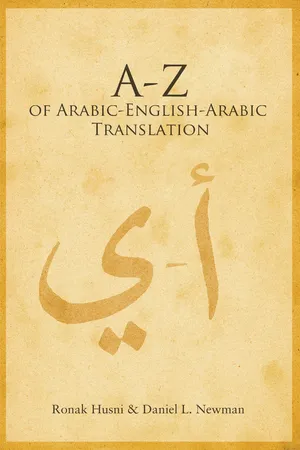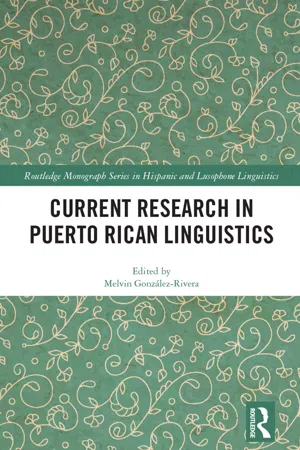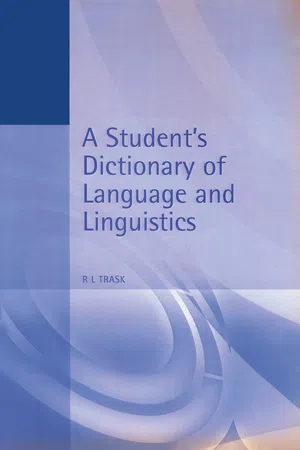Languages & Linguistics
Abbreviations
Abbreviations are shortened forms of words or phrases that are commonly used in written and spoken language. They are often used to save time and space, and can be found in a variety of contexts, including academic writing, business communication, and social media. Some examples of common abbreviations include "etc." for "et cetera," "i.e." for "that is," and "e.g." for "for example."
Written by Perlego with AI-assistance
4 Key excerpts on "Abbreviations"
- eBook - ePub
- R. R. K. Hartmann, Gregory James(Authors)
- 2002(Publication Date)
- Routledge(Publisher)
A
abbreviationA shortened form of a word, phrase or term which represents its full form. Abbreviations can be subdivided into ‘clippings’ (vet for veterinary surgeon), ‘contractions’ (don’t for do not), ‘acronyms’ (EURALEX for European Association for Lexicography), ‘initialisms’, ‘aerophones’ or ‘alphabetisms’ (DRC for Dictionary Research Centre, VIP for very important person) and ‘blends’ (brunch for breakfast/lunch). Reference works vary in their treatment of Abbreviations. In general dictionaries, they may be given HEADWORD status, or be covered in separate lists in the front or back matter.Abbreviations are often used in dictionaries to indicate a word’s grammatical role (e.g. vt for transitive verb) or morphological features (e.g. m or masc for masculine) or to label a particular usage (e.g. obs for obsolete). Annotated lists of the Abbreviations used are normally given in the USER’S GUIDE or elsewhere.CODE (2), EXPANSION, TEXT COMPRESSION.Landau 1984, Cannon 1990, ISO 1990, McArthur 1992, Svensén 1993.Acronyms, Initialisms and Abbreviations Dictionary (J.E.Towell), Detroit MI, 1989; The Oxford Dictionary of Abbreviations, Oxford, 1992.WWW Acronym and Abbreviation Server. www.ucc.ie/info/net/acronyms/index.htmlThe first three letters of the LATIN ALPHABET, often found in the titles of primers or introductory works on any subject, as a synonym of ‘introductory dictionary’.ABCXYZ.A.B.C. of English Usage (H.A.Treble & G.H. Vallins), Oxford, 1936; ABC of Plain Words - eBook - ePub
- Ronak Husni, Daniel L. Newman(Authors)
- 2013(Publication Date)
- Saqi Books(Publisher)
Abbreviations/acronyms
In English, it is common to abbreviate words. One generally makes a distinction between Abbreviations and acronyms in that the latter can be read as words. Consider the difference between ‘ETA’ (expected time of arrival) and ‘NATO’ (North Atlantic Treaty Organization). In the former, each letter is pronounced separately (/i: -ti: -ei/), whereas the latter is read as /neitou/. Whilst acronyms are generally capitalized, Abbreviations tend to be in lower case, except if they involve proper nouns or technical terms. e.g. ‘FAO’ (Food and Agricultural Organization’), ‘DNA’ (deoxyribonucleic acid).In some cases, acronyms become so ‘naturalized’ in the language that their acronymic origins have been forgotten and, consequently, they appear in lowercase. e.g. ‘laser’ (< ‘LASER’, Light Amplification by Stimulated Emission of Radiation), ‘radar’ (< ‘RADAR’, Radio Detection And Ranging).Acronyms are often added with suffixes. e.g. yuppi e (‘young upwardly mobile professional’),dinky(‘double income with no kids [yet]’).A particular type of abbreviation is so-called ‘clipping’, which is also known as ‘truncation’, and involves the cutting of one or more syllables from a word (usually at the end). Whilst some are part of informal usage (e.g. doc , ‘document’), several have gained independent status. e.g. ad (advertisement), lab (laboratory), sub (submarine), deli (delicatessen <shop>), demo (demonstration), zoo (zoological gardens), fax (facsimile), cab (cabriolet), bus (omnibus).In principle, Abbreviations are unknown in Classical Arabic, even if there are some examples like (‘to say (to say or ‘God bless him and grant him salvation’), which is added after a mention of the Prophet Muhammad. Western-style Abbreviations and acronyms are a very recent invention under the influence of English. e.g. ‘PO Box’). They remain quite rare and are generally restricted to media Arabic. e.g. (‘AFP’, the news agency Agence France Presse ), (OPEC), (NATO), - eBook - ePub
- Melvin Gonzalez-Rivera(Author)
- 2017(Publication Date)
- Routledge(Publisher)
cabrón, this term is also very offensive when used in other contexts. Therefore, the meaning giving in the text messages is one of bonding in the same way that the terms of endearments work for the interaction between males and females. These terms may represent an attempt to affirm an unspoken identity among texters and their relationship within their message exchange and getting their meaning across through performativity.6.13 Abbreviations
Abbreviations were very common among both males and females and across proficiency levels. Below are some examples of how participants abbreviated, merged, and spelled Spanish and English words:(38) Male: Q acs? (Qué haces?) ‘What are you doing?’ (39) Female:Dond stas? (Donde estás?)‘Where are you?’ (40) Male:Llama plis te amo bye.‘Call me please I love you bye’ (41) Male:no klases los viernes. Thats exelent ‘No clases on Friday. That’s excellent’ Abbreviation is one of the most relevant linguistic features salient in the corpus. Both males and females showed Abbreviations in both English and Spanish. The choices of words were very similar and consistent across participants: loka, stas, porq showed that participants are comfortable using these variations in Spanish. Originally, texters and online communities used these Abbreviations to economize characters. Yet, as the examples above show, in some cases they are not economizing characters, as in the case of loka instead of loca. Therefore these expressions show a difference in informal (loka) and formal (loca) register. It is becoming more common in social media as well as in texting to use this non-standard abbreviation of this word. Thus language is being reshaped by these interactions prompted by CMC and texters are creating their own identity as part of this interaction by the choices they make when spelling these words, which is aligned with Tagg (2012). These patterns also show how texting provides a space for multiple identities to emerge through performativity and creativity in language use.The spelling of please as plis - Larry Trask(Author)
- 2014(Publication Date)
- Routledge(Publisher)
clipped form.abbreviatory convention Any standard way of using conventional symbols in order to state a linguistic generalization very briefly. In phonology, for example, the statement V[+ high] → Ø / V___{C,#}, which conventionally means “a high vowel is deleted when it is both preceded by another vowel and followed either by a consonant or by the end of a word” illustrates several abbreviatory conventions: the use of the symbols V and C for “any vowel” and “any consonant”, the use of the symbol → for “changes to”, the use of Ø for “nothing at all”, the use of / for “in the following circumstances”, the use of ________ for “in this position”, and the use of # for “a word boundary”.Abduction A particular type of reasoning, in which a person observes a phenomenon Y, remembers a generalization that can derive Y from X, and concludes that X is therefore true. While logically invalid, this type of reasoning is widely regarded as important both in the acquisition of language by children and in producing language change. An example is the replacement of the traditional form There are a lot of people here by the innovation There’s a lot of people here in the speech of many speakers. Presumably speakers noted that the word there comes first in such sentences, recalled that the subject of a sentence normally comes first, and concluded that the subject in this case must be there (and that the verb must therefore agree with there, and not with a lot of people).Abercrombie, David A British phonetician (1909–92), prominent as a researcher, a teacher and a writer; he coined a good deal of the terminology of phonetics.ablative In a language with case, that case form which typically expresses the meaning ‘out of’ or ‘away from’. For example, the Turkish noun ev ‘house’ has an ablative evden
Index pages curate the most relevant extracts from our library of academic textbooks. They’ve been created using an in-house natural language model (NLM), each adding context and meaning to key research topics.
Explore more topic indexes
Explore more topic indexes
1 of 6
Explore more topic indexes
1 of 4



